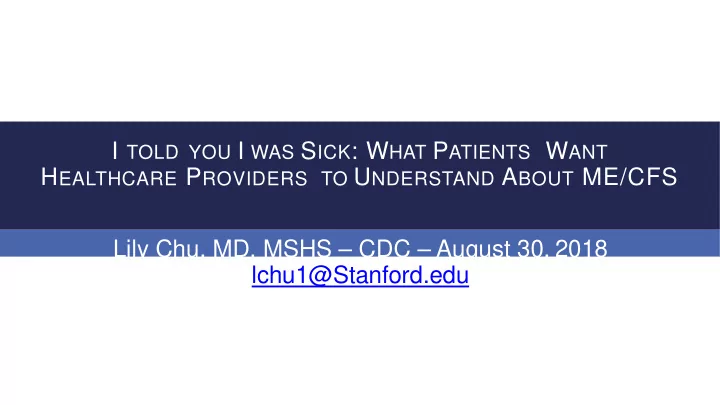

I TOLD YOU I WAS S ICK : W HAT P ATIENTS W ANT H EALTHCARE P ROVIDERS TO U NDERSTAND A BOUT ME/CFS Lily Chu, MD, MSHS – CDC – August 30, 2018 lchu1@Stanford.edu
Seven Recurrent Themes ME/CFS is real: believe patients’ experiences Don’t confuse ME/CFS with chronic fatigue Post-exertional malaise ≠ post-exertional fatigue Getting a diagnosis is vital Recognize how severe the condition can be. Even without a cure, there are many actions clinicians can take to help patient Patients (pt.) can offer unique knowledge/ perspectives
1) #believeME: ME/CFS Is Real You need to: “find something to do with your time other than sit around and complain.” “stop being so ambitious.” 95% felt estranged “resolve your issues with your dad” 77% labelled as psychological “get a boyfriend” “get married” “have a baby” case by at least one MD. “go on vacation.” “drink more coffee.” “I don’t believe in ME/CFS” “ME/CFS is made up” Clinicians add to disease “Everyone experiences fatigue” burden, miss treatment “You’re just stressed out from work.” opportunities and diagnoses. “Are you sure you aren’t depressed?”
2) ME/CFS ≠ chronic fatigue Don’t confuse disease with symptom ME/CFS is more than chronicfatigue Post-exertional malaise (PEM), problems thinking, feeling sick, etc. more disabling Inquire, evaluate, treat, monitorall symptoms
3) PEM ≠ Post-exertional Fatigue Symptom Physical/ cognitive Emotional Distress exertion N = 144 (%) N = 144 (%) Median # Sx. 7 ± 2.8 5 ± 3.3 Fatigue 135 (94%) 109 (76%) Problems 106 (74%) 88 (61%) thinking Muscle pain 106 (74%) 48 (33%) Sleep disturbance 97 (67%) 95 (66%) Flu-like feelings 88 (61%) 47 (33%) Joint pain 77 (53%) 30 (21%) Headache 73 (51%) 53 (37%) Sore Throat 60 (42%) 28 (19%)
4) Getting A Diagnosis Is Vital Knowledge not the only barrier 70% MDs: “disabling self-fulling prophecy” ; “promotes adoption of sick role”; doesn’t impact treatment 90% of patients: positive “turning point” Relieves anxiety/ fears Validates pt. experience: avoid “dustbin of neurotic complainer” Helps pt. and family cope/ strategize treatment/ explain Needed for supportive care
5) Recognize The Severity of ME/CFS 25% bedridden/ homebound Others must restrict/ reduce/ monitor activities 6X suicide risk Influences pt. care SF-36 Subscale scores
6) Actions Clinicians Can Take Now! Assess function/ needs Provide supportive documentation Identify/ treat pain and sleep issues Be alert for treatable co-morbidities Start low, go slow with medications Improve pt. health, function, quality of life
7) Incorporate Patients’ Insights/ Perspectives Patients’ lives depend on solving ME/CFS Listening would have prevented harm from GET/ CBT NAM “Clinical Practice Guidelines We Can Trust” 1. Include patients on development/ reviewer panels 2. Consider patient treatment preferences 3. Take clinical subgroups into account Patients’ views have been ignored/ dismissed for decades. Yet they often have real-world, time-tested knowledge/ experience to contribute.
References – 1 – lchu1@Stanford.edu Green J, Romei J, Natelson BH. Stigma and Chronic Fatigue Syndrome. Journal of Chronic Fatigue Syndrome. 1999 Jan 1;5(2):63–75. The Stigma of Chronic Fatigue Syndrome II: Readers Respond [Internet]. Psychology Today. [cited 2018 Aug 28]. Available from: http://www.psychologytoday.com/blog/turning-straw-gold/201105/the- stigma-chronic-fatigue-syndrome-ii-readers-respond Chu L, Valencia IJ, Garvert DW, Montoya JG. Deconstructing post-exertional malaise in myalgic encephalomyelitis/ chronic fatigue syndrome: A patient-centered, cross-sectional survey. PLOS ONE. 2018 Jun 1;13(6):e0197811. Woodward RV, Broom DH, Legge DG. Diagnosis in chronic illness: disabling or enabling--the case of chronic fatigue syndrome. J R Soc Med. 1995 Jun;88(6):325–9. Chew-Graham C, Dowrick C, Wearden A, Richardson V, Peters S. Making the diagnosis of Chronic Fatigue Syndrome/Myalgic Encephalitis in primary care: a qualitative study. BMC Fam Pract. 2010 Feb 23;11:16. Huibers MJH, Wessely S. The act of diagnosis: pros and cons of labelling chronic fatigue syndrome. Psychol Med. 2006 Jul;36(7):895–900.
References - 2 Nacul LC, Lacerda EM, Campion P , Pheby D, Drachler M de L, Leite JC, et al. The functional status and well being of people with myalgic encephalomyelitis/chronic fatigue syndrome and their carers. BMC Public Health. 2011 May 27;11(1):402. Pendergrast T , Brown A, Sunnquist M, Jantke R, Newton JL, Strand EB, et al. Housebound versus nonhousebound patients with myalgic encephalomyelitis and chronic fatigue syndrome. Chronic Illn. 2016 Dec;12(4):292–307. Roberts E, Wessely S, Chalder T , Chang C-K, Hotopf M. Mortality of people with chronic fatigue syndrome: a retrospective cohort study in England and Wales from the South London and Maudsley NHS Foundation Trust Biomedical Research Centre (SLaM BRC) Clinical Record Interactive Search (CRIS) Register. The Lancet. 2016 Apr;387(10028):1638–43. http://www.nationalacademies.org/hmd/Reports/2011/Clinical-Practice-Guidelines-We-Can-Trust.aspx
Recommend
More recommend